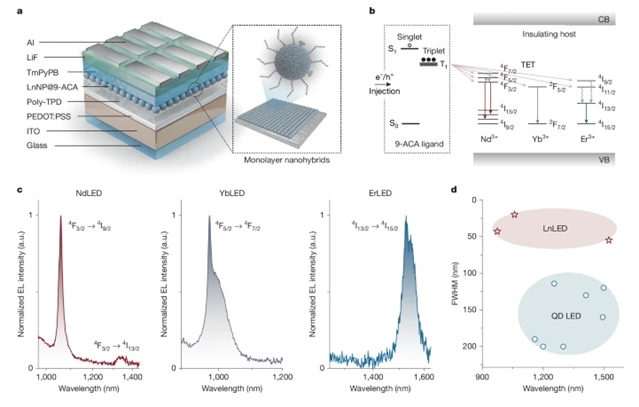
近日,英国剑桥大学Rao, Akshay团队报道了电激发三重态激活绝缘稀土掺杂纳米颗粒。这一研究成果发表在2025年11月19日出版的《自然》杂志上。
绝缘纳米材料因其能隙较大,通常需要在高强度辐射或高温、高压、高电压等极端条件下才能实现电学调控。稀土掺杂绝缘纳米颗粒(LnNPs)因其卓越的发光特性被广泛研究,包括在第二近红外(NIR-II)窗口具有高亮度、窄线宽、无闪烁和无漂白等优势。然而,在低偏压条件下电生成这类绝缘纳米材料的激发态始终未能实现,导致其无法应用于光电器件领域。
研究组报道了一种通过电激发途径实现LnNPs发光的新方法。通过构建LnNP@有机分子纳米杂化体系,使注入电荷在有机分子上复合后,通过高效的三重态能量转移(TET)至LnNPs,成功在低工作电压下激活LnNPs发光。研究组将该激发路径应用于发光二极管(LED),实现了约5伏的低开启电压、极窄的电致发光(EL)谱线,并在NIR-II窗口获得了峰值外量子效率(EQE)超过0.6%的突破。通过调控稀土掺杂剂的种类与浓度,基于LnNPs的LED(LnLEDs)还可实现电致发光特性的广谱调谐。这些研究成果开创了杂化光电器件新领域,为基于稀土纳米材料的电驱动激发源在生物医学和光电子学中的应用开辟了新途径。
附:英文原文
Title: Triplets electrically turn on insulating lanthanide-doped nanoparticles
Author: Yu, Zhongzheng, Deng, Yunzhou, Ye, Junzhi, van Turnhout, Lars, Liu, Tianjun, Tew, Alasdair, Arul, Rakesh, Dowland, Simon, Sun, Yuqi, Li, Xinjuan, Dai, Linjie, Lu, Yang, Ducati, Caterina, Baumberg, Jeremy J., Friend, Richard H., Hoye, Robert L. Z., Rao, Akshay
Issue&Volume: 2025-11-19
Abstract: Insulating nanomaterials have large energy gaps and are only electrically accessible under extreme conditions, such as high-intensity radiation and high temperature, pressure or voltage1,2. Lanthanide-doped insulating nanoparticles (LnNPs) are widely studied owing to their exceptional luminescence properties, including bright, narrow-linewidth, non-blinking and non-bleaching emission in the second near-infrared (NIR-II) range3,4. However, it has not been possible to electrically generate excited states in these insulating nanomaterials under low biases and, therefore, not possible to fabricate optoelectronic devices from these systems. Here we report an electrical excitation pathway to obtain emission from LnNPs. By forming LnNP@organic molecule nanohybrids, in which the recombination of electrically injected charges on the organic molecule is followed by efficient triplet energy transfer (TET) to the LnNP, it is possible to turn on LnNPs under a low operating bias. We demonstrate this excitation pathway in light-emitting diodes (LEDs), with low turn-on voltages of about 5V, very narrow electroluminescence (EL) spectra and a peak external quantum efficiency (EQE) greater than 0.6% in the NIR-II window5. Our LnNP-based LEDs (LnLEDs) also allow for widely tunable EL properties, by changing the type and concentration of lanthanide dopants. These results open up a new field of hybrid optoelectronic devices and provide new opportunities for the electrically driven excitation sources based on lanthanide nanomaterials for biomedical and optoelectronic applications.
DOI: 10.1038/s41586-025-09601-y
Source: https://www.nature.com/articles/s41586-025-09601-y
Nature:《自然》,创刊于1869年。隶属于施普林格·自然出版集团,最新IF:69.504
官方网址:http://www.nature.com/
投稿链接:http://www.nature.com/authors/submit_manuscript.html
